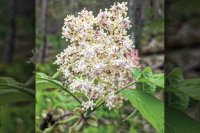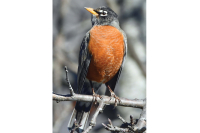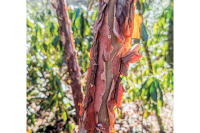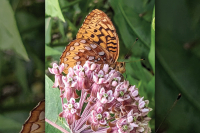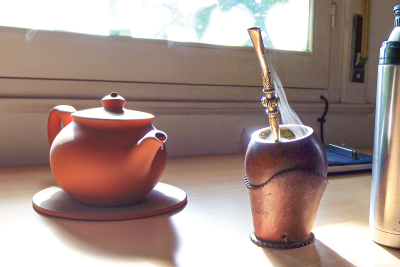Stop and smell the … ferns
 One of my favorite times to observe ferns is in winter when they stand out in the brown leaf-litter. Of the 70 or so species that have been documented in the southern mountains, perhaps a fourth are evergreen. These would include walking fern, rockcap fern, resurrection fern, intermediate wood fern, several of the so-called “grape fern” species, and others.
One of my favorite times to observe ferns is in winter when they stand out in the brown leaf-litter. Of the 70 or so species that have been documented in the southern mountains, perhaps a fourth are evergreen. These would include walking fern, rockcap fern, resurrection fern, intermediate wood fern, several of the so-called “grape fern” species, and others.
Beyond blueberries: Backyard cornucopia revealed at native plants conference
 Taking a walk with Ila Hatter is the outdoors equivalent of sitting beside a scrapbooker as she pages through the family photo album. Every step is a story, a meeting with a plant bearing its own history and its own place in the present.
Taking a walk with Ila Hatter is the outdoors equivalent of sitting beside a scrapbooker as she pages through the family photo album. Every step is a story, a meeting with a plant bearing its own history and its own place in the present.
“I think stories help you remember,” Hatter said. “They give you something to hold onto as you’re learning plants.”
Sourwood honey is a favorite among connoisseurs
 Now is sourwood time. From late June into mid-August sourwood trees will be flowering throughout Western North Carolina, from the lowest elevations to almost 5,000 feet. Here, then, more or less at random, are some notes from my sourwood file:
Now is sourwood time. From late June into mid-August sourwood trees will be flowering throughout Western North Carolina, from the lowest elevations to almost 5,000 feet. Here, then, more or less at random, are some notes from my sourwood file:
In a lurch about larch: Mystery tree leaves retired professor probing for answers
 To the untrained eye, the tree looks like just another evergreen, just another species thrown into the mix of natural diversity along the Blue Ridge Parkway. But the American larch tree growing opposite the pull-off for Courthouse Valley Overlook fails on both counts: though it’s in the pine family, it is not an evergreen, and it is not a native.
To the untrained eye, the tree looks like just another evergreen, just another species thrown into the mix of natural diversity along the Blue Ridge Parkway. But the American larch tree growing opposite the pull-off for Courthouse Valley Overlook fails on both counts: though it’s in the pine family, it is not an evergreen, and it is not a native.
“This just blew me out of the water a little bit,” said Dan Pittillo, the retired Western Carolina University botany professor who found the tree. “I didn’t expect it.”
Shagbark hickory among the most interesting in WNC
 The walnut family is relatively small, but it contains some of the more interesting and valuable tree species found in Western North Carolina. In WNC there are only two genera, the walnuts (Juglans) and the hickories (Carya).
The walnut family is relatively small, but it contains some of the more interesting and valuable tree species found in Western North Carolina. In WNC there are only two genera, the walnuts (Juglans) and the hickories (Carya).
Buckeyes still beguile nature lovers
 A large yellow buckeye tree overhangs and supports the swinging gate that accesses our property. The tree has started to drop the unique fruiting structures for which it is named. Year around, it always has something interesting going on.
A large yellow buckeye tree overhangs and supports the swinging gate that accesses our property. The tree has started to drop the unique fruiting structures for which it is named. Year around, it always has something interesting going on.
Liverworts — a unique bridge in the plant world
 Some years ago, when I first became interested in plant identification, I became curious about liverworts. They are one of the distinctive plant groups (like fungi, lichens, mushrooms, etc.) without advanced vascular systems.
Some years ago, when I first became interested in plant identification, I became curious about liverworts. They are one of the distinctive plant groups (like fungi, lichens, mushrooms, etc.) without advanced vascular systems.
A book every naturalist needs on his or her shelf
Naturalist Donald Culross Peattie (1898-1964) was born in Chicago. In his autobiography The Road of a Naturalist (1941), Peattie recalled his first extended visit to the North Carolina mountains in 1906 as a time when he “saw the world of people fall away, grow small, grow hazy blue, forgotten. In seven months upon that isolated summit of the Appalachians, I began to discover a world older and greater. It is the world now of my established habitation, my working days and holidays, and it lies open to all men, in valleys as on mountains, by any road you choose to enter.”
Serviceberry is recurring harbinger of spring
I have two options when driving back and forth from home to town. One is along a river and the other isn’t. The choice is easy. I always follow the route along the north side of the Tuckaseigee west of Bryson City. If asked to name that section of road I’d name it for a tree. I’d call it Sarvis Road because every year that’s where I note for the first time — as I did this past Monday — that serviceberry is in bloom. The showy white flowers with their ribbon-like petals are frequently so numerous on a given tree’s bare limbs they seem to be inundated with snow. They seem even whiter this year.
The hardest tree in North America
I wrote a tribute to the black locust tree some time back. It’s time to take another look. This time around we’ll incorporate the perspectives of a French arborist who visited America during the mid-nineteenth century.
Locust is a winter tree. Outdoors, it’s durable in extreme weather and indoors, it makes superb firewood. When I refer to locust, it’s to black locust (Pseudoacacia robinia), not one of the several other species in that genus such as honey locust.

